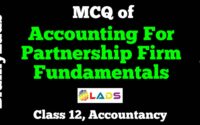MCQ of Accounting Ratios | Class 12 | Accountancy | Term-1 | CBSE |
MCQ of Accounting Ratios, Class 12, Accountancy, Term-1, CBSE
Q1. ………. involves the comparison of a firm’s ratio with that of some selected firms in the same industry or industry average at the same point of time.
- Time series analysis
- Cost analysis
- Cross sectional analysis
- Data analysis
Answer: Cross sectional analysis
Q2. …………. involves comparison of a firm’s present ratio with its past ratios.
- Time series analysis
- Cost analysis
- Cross sectional analysis
- Data analysis
Answer: Time series analysis
Q3. the objective of ratio analysis is to
- place an exact value of goodwill
- Ascertain the payment of cash and cash equivalent
- Locate the weak spots of business which need more attention
- Provide summary of personal and real account
Answer: Locate the weak spots of business which need more attention
Q4. Current assets does not include
- Short term loan and advance
- Short term borrowing
- Current investment
- Trade receivable
Answer: Short term borrowing
Q5. ……. ratios are calculated on the basis of ‘Cost of revenue from Operation’.
- Liquidity ratio
- Solvency ratio
- Activity ratio
- Profitability ratio
Answer: Activity ratio
Q6. Current ratio =
- Current liability/ Current assets
- Current assets/ Current liabilities
- Liquid assets/ Current liabilities
- Current liabilities/ Liquid aassets
Answer: Current assets/ Current liabilities
You may also read MCQ of Accounting For Partnership Firm-Fundamentals, MCQ of Change in Profit Sharing Ratio, MCQ of Admission of a Partner, MCQ of Financial Statements of Companies for better score and understanding of Accountancy.
Q7. Quick ratio =
- Current liabilities/ Current assets
- Current assets/ Current liabilities
- Liquid assets/ Current liabilities
- Current liabilities/ Liquid assets
Answer: Liquid assets/ Current liabilities
Q8. Two basic measures of liquidity involve
- Current ratio and average collection period
- Gross profit margin and operating ratio
- Current ratio and liquid ratio
- Inventory turnover and current ratio
Answer: Current ratio and liquid ratio
Q9. Which of the following is an ideal current ratio?
- 1:2
- 2:1
- 1:1
- 1:3
Answer: 2:1
Q10. Which of the following is an ideal Quick ratio?
- 1:2
- 2:1
- 1:1
- 1:3
Answer: 1:1
Q11. Solvency ratio includes
- Gross profit ratio
- Interest coverage ratio
- Net profit ratio
- Operating ratio
Answer: Interest coverage ratio
Q12. Profitability ratio is also known as
- Debt equity ratio
- Proprietary ratio
- Income ratio
- Total assets to debt ratio
Answer: Income ratio
Q13. Profitability ratio includes
- Proprietary ratio
- Return on investment
- Interest coverage ratio
- Debt equity ratio
Answer: Return on investment
Q14. Current assets doesn’t include
- Trade payable
- Short term loan
- Current investment
- Cash and cash equivalent
Answer: Trade payable
Q15. Current liabilities don’t include
- Short term loan
- Short term provision
- Short term borrowing
- Sundry creditors
Answer: Short term loan
Q16. Activity ratios include
- Proprietary ratio
- Debt equity ratio
- Operating ratio
- Stock turnover ratio
Answer: Stock turnover ratio
Q17. Turnover ratio is also called as
- Net profit ratio
- Activity ratio
- Income ratio
- Solvency ratio
Answer: Activity ratio
Q18. Formula for calculating liquid assets is
- Inventories – Prepaid expense + current assets
- Current assets + Inventories – advance tax
- Current assets – inventories – prepaid expenses
- Prepaid expenses – current assets
Answer: Current assets – inventories – prepaid expenses
Q19. ………… Ratio is expressed as relationship between long term debts and shareholder’s funds.
- Total assets to debt ratio
- Debt equity ratio
- Current ratio
- Liquidity ratio
Answer: Debt equity ratio
Q20. ……… Ratio is expressed as relationship between total assets and long term debts.
- Total assets to debt ratio
- Debt equity ratio
- Current ratio
- Liquidity ratio
Answer: Total assets to debt ratio
Q21. Working capital =
- Current assets / Current liabilities
- Current assets – Current liabilities
- Current liabilities / Current assets
- Current liabilities – Current assets
Answer: Current assets – Current liabilities
Q22. One of the objectives of profitability ratio is
- to measure the rate of net profit earned on revenue from operation
- to measure the margin of profit available on revenue from operation
- to measure how efficiently the capital employed in the business is being used
- None of the above
Answer: To measure the margin of profit available on revenue from operation
Q23. One of the objectives of Net Profit Ratio is
- to measure the rate of net profit earned on revenue from operation
- to measure the margin of profit available on revenue from operation
- to measure how efficiently the capital employed in the business is being used
- None of the above
Answer: To measure the rate of net profit earned on revenue from operation
Q24. Return on investment is also known as
- Capital investment
- Net return
- Yield on capital
- Capital employed
Answer: Yield on capital
Q25. Ability of the business to pay its long term liabilities is called
- Profitability of business
- Liquidity of business
- Solvency of business
- Insolvency of business
Answer: Solvency of business
Q26. Earning capacity of the business is called
- Profitability of business
- Liquidity of business
- Solvency of business
- Insolvency of business
Answer: Profitability of business
Q27. One of the limitations of accounting ratio is that it ignore ……… factors.
- Quantitative
- Qualitative
- Definitive
- Gross
Answer: Qualitative
Q28. Calculate current ratio
- 1:2
- 2:1
- 1:3
- 2:3
Answer: 2:1
Q29. Current Ratio is 3:5:1
Working Capital : Rs. 90,000
Calculate the amount of Current Assets and Current Liabilities.
- Current liabilities 36000 and current assets 126000
- Current liabilities 25 000 and current assets 120000
- Current liabilities 30000 and current assets 125000
- Current liabilities 34000 and current assets 124000
Answer: Current liabilities 36000 and current assets 126000
Q30. Handa Ltd. had inventory of Rs. 20,000. Total Liquid assets are Rs. 1,00,000 and quick ratio is 2:1. Calculate the current ratio.
- 1 : 2.4
- 2 : 1
- 2.4 : 1
- 1:3
Answer: 2.4:1
Q31. Calculate Inventory Turnover Ratio if :
Inventory in the beginning is Rs. 76,250
Inventory at the end is Rs. 98,500
Gross Revenue from operations is Rs. 5,20,000
Return Inwards is Rs. 20,000.
Purchase is Rs. 3,22,250
- 2 times
- 3.43 times
- 4.5 times
- 5 times
Answer: 3.43 times
Q32.
- Quick ratio 0.54 : 1 ; inventory turnover ratio 3.74 times ; return on investment 41.17 %
- Quick ratio 0.2 : 1 ; inventory turnover ratio 2 times ; return on investment 51.3 %
- Quick ratio 0.35 : 1 ; inventory turnover ratio 3.12 times ; return on investment 36.3 %
- Quick ratio 1:2 ; inventory turnover ratio 2.54 times ; return on investment 39.2 %
Answer: Quick ratio 0.54 : 1 ; inventory turnover ratio 3.74 times ; return on investment 41.17 %
Q33. Calculate ‘Debt-Equity Ratio’ from the following information.
Total Assets : Rs. 3,50,000
Total Debt : Rs. 2,50,000
Current Liabilities : Rs. 80,000
- 1:2
- 1.7 : 1
- 2.1 : 1
- 3:1
Answer: 1.7:1
Q34. Calculate interest coverage ratio from the following information.
Net profit (After Taxes) = Rs. 1,00,000
Fixed Interest charges on long term borrowing = Rs. 20,000
Rate of Income Tax : 50%
- 9 times
- 10 times
- 11 times
- 13 times
Answer: 11 times
Q35. Cost of revenue from operations is Rs. 5,00,000. The opening stock is Rs. 40,000 and the closing stock is Rs. 60,000 (at cost). Calculate inventory turnover ratio.
- 9 times
- 10 times
- 11 times
- 13 times
Answer: 10 times
Do share the post if you liked the MCQ of Accounting Ratios. For more updates, keep logging on BrainyLads




